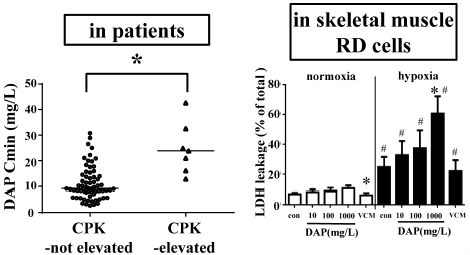- 著者
- Masaki KOBAYASHI
- 出版者
- 国立国会図書館
- 雑誌
- National Diet Library newsletter (ISSN:13447238)
- 巻号頁・発行日
- no.213, 2017-08
- 著者
- Takehiro Yamada Shuhei Ishikawa Nobuhisa Ishiguro Masaki Kobayashi Ken Iseki
- 出版者
- The Pharmaceutical Society of Japan
- 雑誌
- Biological and Pharmaceutical Bulletin (ISSN:09186158)
- 巻号頁・発行日
- vol.43, no.9, pp.1338-1345, 2020-09-01 (Released:2020-09-01)
- 参考文献数
- 28
- 被引用文献数
- 2 3
Daptomycin, a cyclic lipopeptide antibiotic, has bactericidal activity against Gram-positive organisms and is especially effective against methicillin-resistant Staphylococcus aureus. Although daptomycin causes unique adverse drug reactions such as elevation of creatine phosphokinase or rhabdomyolysis, the detailed mechanisms underlying these adverse drug reactions in skeletal muscle are unclear. This study aimed to elucidate whether daptomycin causes direct skeletal muscle cell toxicity and investigate the relationship between daptomycin exposure and musculoskeletal toxicity. First, we evaluated the relationship between daptomycin exposure and skeletal muscle toxicity. Of the 38 patients who received daptomycin intravenously, an elevation in creatine phosphokinase levels was observed in five. The median plasma trough concentration of daptomycin in patients with elevated creatine phosphokinase levels was significantly higher than that in patients whose creatine phosphokinase levels were within the normal range, suggesting that increased exposure to daptomycin is related to elevation in creatine phosphokinase levels. In an in vitro study using human rhabdomyosarcoma cells, daptomycin reduced cell viability and increased membrane damage. These effects were more marked under hypoxic conditions. A necroptotic pathway seemed to be involved because phosphorylated mixed lineage kinase domain-like protein expression was enhanced following daptomycin exposure, which was significantly enhanced under hypoxic conditions. These findings indicate that daptomycin elicits cytotoxic effects against skeletal muscle cells via the necroptotic pathway, and the extent of toxicity is enhanced under hypoxic conditions.
1 0 0 0 OA Analysis of α-Defensin 5 Secretion in Differentiated Caco-2 Cells: Comparison of Cell Bank Origin
- 著者
- Genki Yasuda Masaki Kobayashi Atsuhito Kubota Katsuya Narumi Ayako Furugen Yoshitaka Saito Takashi Satoh Natsuko Suzuki Ken Iseki
- 出版者
- The Pharmaceutical Society of Japan
- 雑誌
- Biological and Pharmaceutical Bulletin (ISSN:09186158)
- 巻号頁・発行日
- vol.44, no.2, pp.275-278, 2021-02-01 (Released:2021-02-01)
- 参考文献数
- 16
- 被引用文献数
- 2
α-Defensin 5 has a particularly broad antibacterial spectrum; it eliminates pathogenic microorganisms and regulates intestinal flora. Although Caco-2 cells are similar to small intestinal cells, it is unclear whether they secrete α-defensin 5. Therefore, we investigated whether Caco-2 cells secrete α-defensin 5 and determined the secretion mechanism using cells from three cell banks (ATCC, DSMZ, and RIKEN). The Caco-2 cell proliferation rate increased with the number of culture days, irrespective of cell bank origin. On the other hand, the alkaline phosphatase activity, which affects cell differentiation and the mRNA levels of several cytokines, such as interleukin 8 (IL-8), IL-6, IL-1β, tumor necrosis factor-α (TNF-α), and IL-2, in the Caco-2 cells fluctuated with the number of culture days, and differed for each cell bank. α-Defensin 5 secretion was detected in all three cell bank Caco-2 cells; particularly, the ATCC Caco-2 cells grew linearly depending on the cell culture day as well as the levels of IL-8 and TNF-α mRNA. This suggested that α-defensin 5 secretion in the ATCC Caco-2 cells was associated with fluctuations in the mRNA levels of various cytokines, such as IL-8 and TNF-α. In conclusion, Caco-2 cells may be a simple model for screening health food components and drugs that affect α-defensin 5 secretion.

